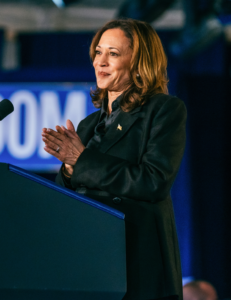So today I thought about rampant misogyny as I listened to portions of the counting of the electoral votes by Vice President Kamala Harris to officially certify Donald Trump as president.
I couldn’t help but think about what I have believed since Hillary Clinton lost her bid for president: sexism and misogyny.
Voter Apathy Among Key Groups
 It’s always easier to analyze history than to predict the future. The reality of Kamala Harris’s loss lies heavily in voter apathy. Many people who would have benefited from her policies simply didn’t show up at the polls. Families struggling for better healthcare, stronger labor unions, and enhanced social services failed to vote in their own best interest. I personally know families who desperately need these services yet opted out of voting. They either believed their vote wouldn’t matter or failed to make time. This is the epitome of a self-fulfilling prophecy: by not voting, they ensured the outcome they most feared—a government less likely to address their needs.
It’s always easier to analyze history than to predict the future. The reality of Kamala Harris’s loss lies heavily in voter apathy. Many people who would have benefited from her policies simply didn’t show up at the polls. Families struggling for better healthcare, stronger labor unions, and enhanced social services failed to vote in their own best interest. I personally know families who desperately need these services yet opted out of voting. They either believed their vote wouldn’t matter or failed to make time. This is the epitome of a self-fulfilling prophecy: by not voting, they ensured the outcome they most feared—a government less likely to address their needs.
This inaction is particularly tragic for those reliant on policies that Democrats historically champion. The refusal to participate in democracy is, effectively, a vote against oneself. This lack of turnout allowed the opposition to triumph, highlighting how voter disengagement can cripple a candidate’s chances, no matter how beneficial their policies might be.
Misogyny and the Barrier of Gender
Kamala Harris’s loss echoes Hillary Clinton’s defeat: both faced entrenched sexism. While Clinton won the popular vote, she lost in the Electoral College, demonstrating that winning nationwide support isn’t enough when key battleground states don’t align. Harris faced a similar uphill battle. A significant segment of the electorate remains unwilling to vote for a woman for president, no matter her qualifications.
Misogyny in America is undeniable. For those not certain about the term, misogyny means a dislike, prejudice, or even hatred toward women just because they are women. It shows up in many ways, like believing that women aren’t as smart or capable as men or thinking that women should only do certain types of jobs. Sometimes, people openly claim that women shouldn’t vote or lead, revealing blatant sexism. Other times, society subtly reinforces unfair treatment toward women through actions and policies. For example, employers often pay women less than men for doing the same job, and people judge women more harshly when they speak assertively. Misogyny doesn’t just manifest as attitudes—it directly shapes laws, workplace dynamics, and relationships, making it even harder for women to achieve equality.
Evangelical Christians and other conservative religious groups often promote the belief that women are inherently subordinate to men. These ideologies persist in parts of the country where traditional gender roles are deeply ingrained, limiting women’s ability to gain widespread support for leadership roles.
This systemic sexism isn’t confined to religion. Women are still underrepresented in positions of power, whether in politics, business, or other sectors. Despite progress, a significant portion of society clings to outdated views about women’s capabilities and roles.
Violence Against Women as a Reflection of Misogyny
Domestic violence and violence against women are rampant in the United States, further illustrating the pervasive disregard for women. These issues are deeply tied to the systemic inequalities that Harris’s candidacy sought to challenge. The persistence of these problems reflects a cultural devaluation of women, making it harder for a woman to gain the respect and trust necessary to lead the nation.
Male Domination and Reluctance to Relinquish Power
Men dominate leadership roles in the U.S., and many are unwilling to relinquish this control. This is evident in both subtle and overt displays of misogyny. Researchers consistently find that society scrutinizes women more harshly than men when they seek leadership. For example, people often praise male leaders for showing assertiveness, but they label women with the same traits as aggressive or unlikable. This double standard remains a significant obstacle.
As time progresses, there is evidence that misogyny is becoming more entrenched. Social media and political rhetoric have amplified sexist attitudes, creating an environment where gender equality is harder to achieve. The reluctance of male leaders to support women’s ascension is a major barrier to progress.
Hope: the Decline of Religious Influence
There is hope for the future: younger generations are distancing themselves from organized religion. This trend could lead to a more equitable society. Many religious doctrines perpetuate the idea of women as second-class citizens. The irony here is striking! Religions often claim to teach goodness and fairness. However, they frequently uphold systems that oppress women. As religious influence wanes, there is potential for a cultural shift that values women more equally and opens the door for female leaders.
However, we are not there yet. Women continue to face significant barriers to achieving true parity in power. The cultural and systemic changes needed for a woman to be widely accepted as a presidential candidate are still in their early stages.
The Unfortunate Reality of Apathy, Misogyny, and Systemic Inequality
Given the current state of gender politics in America, there’s an unfortunate reality. That’s that a woman will only be elected president when both major parties nominate female candidates. This would eliminate the gendered comparisons that often hinder female candidates. Until then, deeply ingrained biases and systemic barriers will continue to thwart the aspirations of women like Kamala Harris.
Harris’s loss is a stark reminder of the work still needed to achieve gender equity in America. Voter apathy, misogyny, and systemic inequality remain significant hurdles. But as societal attitudes evolve, there is hope that future generations will break these barriers. And maybe even embrace the leadership potential of women.
More information about Kamala Harris can be found at her website:
KamalaHarris.com.
 I have been self employed for most of my life. During that self employment, I have had numerous employees. My experience has taught me that regardless of group dynamics and the group’s nature generally, managing employee performance is a pivotal role for all leaders. The success of any organization hinges on the leader’s capability to set clear performance expectations and, in certain situations, guide the methods or processes to be employed.
I have been self employed for most of my life. During that self employment, I have had numerous employees. My experience has taught me that regardless of group dynamics and the group’s nature generally, managing employee performance is a pivotal role for all leaders. The success of any organization hinges on the leader’s capability to set clear performance expectations and, in certain situations, guide the methods or processes to be employed.